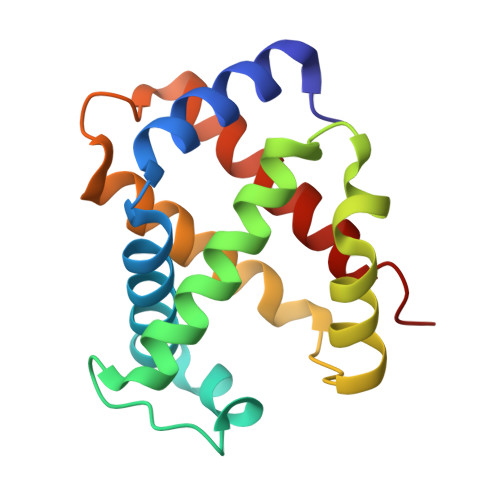Magnesium(II) and zinc(II)-protoporphyrin IX's stabilize the lowest oxygen affinity state of human hemoglobin even more strongly than deoxyheme.
Miyazaki, G., Morimoto, H., Yun, K.M., Park, S.Y., Nakagawa, A., Minagawa, H., Shibayama, N.(1999) J Mol Biol 292: 1121-1136
- PubMed: 10512707
- DOI: https://doi.org/10.1006/jmbi.1999.3124
- Primary Citation of Related Structures:
1QSH, 1QSI - PubMed Abstract:
Studies of oxygen equilibrium properties of Mg(II)-Fe(II) and Zn(II)-Fe(II) hybrid hemoglobins (i.e. alpha2(Fe)beta2(M) and alpha2(M)beta2(Fe); M=Mg(II), Zn(II) (neither of these closed-shell metal ions binds oxygen or carbon monoxide)) are reported along with the X-ray crystal structures of alpha2(Fe)beta2(Mg) with and without CO bound. We found that Mg(II)-Fe(II) hybrids resemble Zn(II)-Fe(II) hybrids very closely in oxygen equilibrium properties. The Fe(II)-subunits in these hybrids bind oxygen with very low affinities, and the effect of allosteric effectors, such as proton and/or inositol hexaphosphate, is relatively small. We also found a striking similarity in spectrophotometric properties between Mg(II)-Fe(II) and Zn(II)-Fe(II) hybrids, particularly, the large spectral changes that occur specifically in the metal-containing beta subunits upon the R-T transition of the hybrids. In crystals, both alpha2(Fe)beta2(Mg) and alpha2(Fe-CO)beta2(Mg) adopt the quaternary structure of deoxyhemoglobin. These results, combined with the re-evaluation of the oxygen equilibrium properties of normal hemoglobin, low-affinity mutants, and metal substituted hybrids, point to a general tendency of human hemoglobin that when the association equilibrium constant of hemoglobin for the first binding oxygen molecule (K1) approaches 0.004 mmHg(-1), the cooperativity as well as the effect of allosteric effectors is virtually abolished. This is indicative of the existence of a distinct thermodynamic state which determines the lowest oxygen affinity of human hemoglobin. Moreover, excellent agreement between the reported oxygen affinity of deoxyhemoglobin in crystals and the lowest affinity in solution leads us to propose that the classical T structure of deoxyhemoglobin in the crystals represents the lowest affinity state in solution. We also survey the oxygen equilibrium properties of various metal-substituted hybrid hemoglobins studied over the past 20 years in our laboratory. The bulk of these data are consistent with the Perutz's trigger mechanism, in that the affinity of a metal hybrid is determined by the ionic radius of the metal, and also by the steric effect of the distal ligand, if present. However, there remains a fundamental contradiction among the oxygen equilibrium properties of the beta substituted hybrid hemoglobins.
Organizational Affiliation:
Division of Biophysical Engineering, Graduate School of Engineering Science, Osaka University, Toyonaka, Osaka, 560-8531, Japan. miyazaki@bpe.es.osaka-u.ac.jp


















